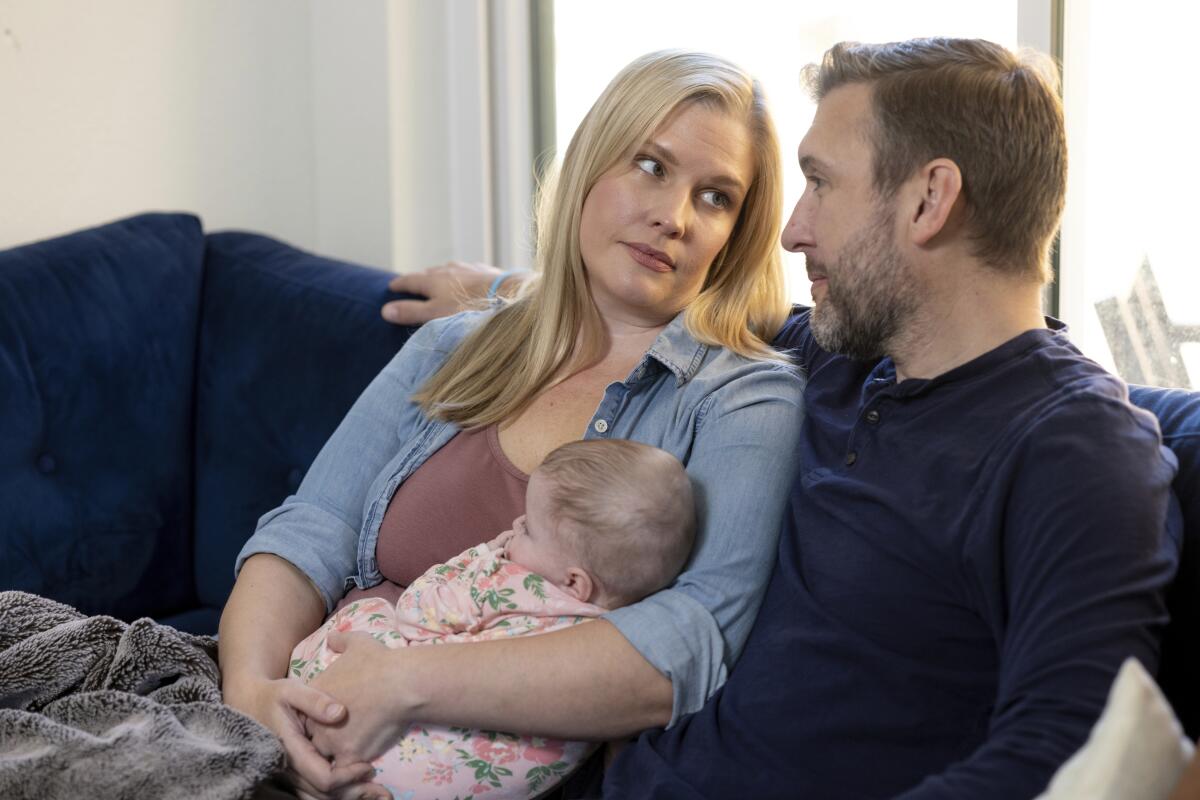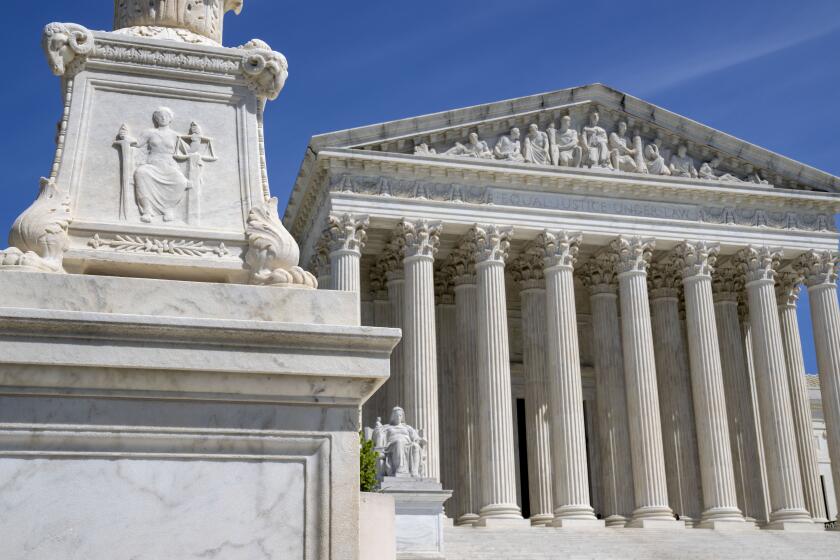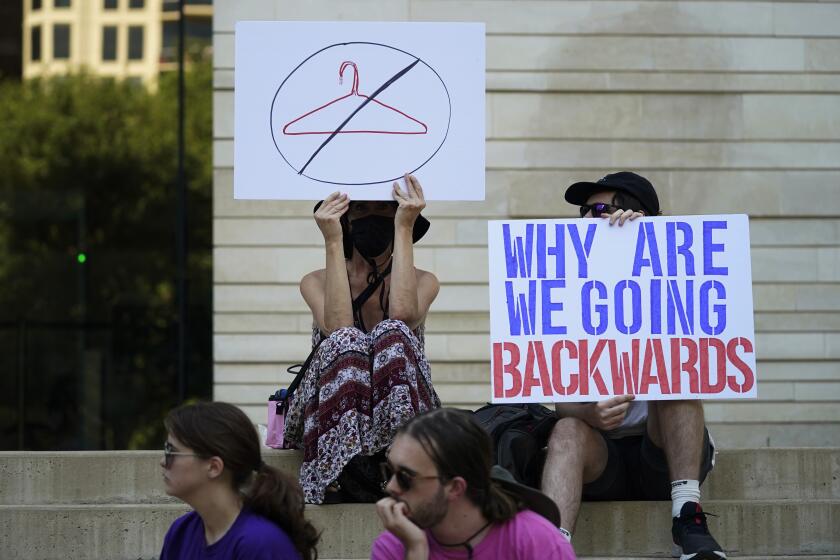Some state abortion bans stir confusion, and it’s uncertain if lawmakers will clarify them

- Share via
Ever since the nation’s highest court ended federal abortion rights more than a year ago, vaguely worded bans enacted in some Republican-controlled states have caused bewilderment over how exceptions should be applied.
Supporters have touted these exemptions, tucked inside statutes restricting abortion, as sufficient enough to protect the life of the woman. Yet repeatedly, when applied in heart-wrenching situations, the results are much murkier.
“We have black and white laws on something that is almost always multiple shades of gray,” said Kaitlyn Kash, one of 20 Texas women denied abortion who are suing the state seeking clarification of the laws — one of a handful of similar lawsuits playing out across the country.
State lawmakers there and elsewhere face growing pressure to answer these questions by amending laws in legislative sessions that start in most states next month. But it’s not certain how — or whether — they will.
Before the Supreme Court overturned the 1973 Roe vs. Wade decision in June 2022, nearly every state allowed abortion at least until a fetus would be viable outside the womb — around 24 weeks’ gestational age, or about 22 weeks after conception.
Yet the new ruling cleared the way for states to impose tighter restrictions or bans; several had such laws already on the books in anticipation of the decision.
Currently, 14 states are enforcing bans on abortion throughout pregnancy. Two more have such bans on hold due to court rulings. And another two have bans that take effect when cardiac activity can be detected, about six weeks into pregnancy — often before women know they’re pregnant.
A Black Ohio woman who miscarried in her bathroom has been charged with abuse of a corpse and her case sent to a grand jury.
Each state ban has a provision that allows abortion under at least some circumstances to save the life of the woman. At least 11 — including three with the strictest bans — allow abortion because of fatal fetal anomalies, and some do when the pregnancy was the result of rape or incest.
But a provision included in a law enacted by Congress in 1986 and signed by Republican President Reagan said abortion must be available when a pregnant woman’s life is at risk during a medical emergency.
But a lack of clarity over how to apply that rule and other exceptions in state laws has escalated the trauma and heartache some women experience while facing serious medical issues but unable to access abortion in their home states.
The case of Katie Cox, a Texas woman who sued for immediate access to abortion amid a fraught pregnancy and was denied by the state’s top court, received broad attention this month.
Attorneys for a pregnant Texas woman who sought court permission for an abortion in a challenge to a ban say she has left the state to obtain the procedure.
Meanwhile, Jaci Statton filed a complaint in Oklahoma claiming the state violated the federal rule. She said in court documents that because her own life wasn’t found to be in immediate peril when doctors deemed her pregnancy nonviable, she was told to wait in a hospital parking lot until her conditioned worsened enough to qualify for life-saving care.
In Tennessee, Nicole Blackmon told reporters that a 15-week ultrasound showed that several of her fetus’ major organs were growing outside its stomach and it would likely not survive. Even so, her medical team told her she didn’t have the option to have an abortion. She eventually delivered a stillborn baby because she could not afford to travel out of state for an abortion.
The vagueness surrounding Tennessee’s abortion ban has prompted Republican state Sen. Richard Briggs’ push to tweak the law during the upcoming 2024 legislative session. However, it’s unclear how far the measure will advance inside the GOP-controlled statehouse where many members are running for reelection.
Republicans carved out an extremely narrow exception earlier this year, but Briggs, who is a doctor, said the statute still fails to properly help women and doctors. He wants the law to include a list of diagnoses when abortion could be appropriate and protect women with pregnancy complications who may end up infertile if they don’t receive an abortion.
Obstacles to obtaining an abortion are more common since the U.S. Supreme Court overturned Roe vs. Wade in June 2022.
Other states took steps in 2023 to address the confusion, but advocates say they didn’t fully accomplish the task.
In Texas, lawmakers this year added a provision that offers doctors some legal protection when they end pregnancies in cases of premature rupture of membranes, commonly referred to as water breaking, or ectopic pregnancies, which can lead to dangerous internal bleeding.
Across the country, advocates on both sides anticipate more legislatures will consider adding or clarifying abortion ban exceptions and definitions in 2024, though few, if any, such measures have been filed so far.
“What is and is not an abortion, what is an abortion emergency?” said Denise Burke, senior counsel with Alliance Defending Freedom, a conservative Christian legal advocacy group that is behind many anti-abortion lawsuits. “That may need some clarification in some areas.”
Meanwhile, in states where Democrats are in control, lawmakers are expected to push to loosen abortion restrictions and expand access.
This year, Maine became the seventh state to have no specific limit on when during pregnancy an abortion can be obtained.
Greer Donley, an associate professor at the University of Pittsburgh School of Law, who is an expert on abortion law, said there could be a push for more changes like that: “Many people are questioning whether a line should exist at all right now.”
The line is stark in Texas, where changes are unlikely in 2024 because lawmakers aren’t scheduled to meet.
In Texas, Kash and 19 other women who were denied abortions, plus two physicians, have a lawsuit before the state’s Supreme Court seeking to clarify when abortions should be allowed.
Kash, who already had one child, was overjoyed at the thought of telling family and friends that she was expecting. But after a routine ultrasound 13 weeks into pregnancy, she learned that the baby had severe skeletal dysplasia — a condition affecting bone and cartilage growth. Her baby was unlikely to survive birth or likely to suffocate soon after being born.
“Is this where we talk about termination?” Kash asked her doctor.
“He told me to get a second opinion out of state,” she recalled.
Her health wasn’t immediately at risk of failing, so she didn’t qualify for any of the narrow exceptions to allow her doctor to provide her abortion services. Instead, she went to another state to terminate her pregnancy legally.
In the arguments on the case last month, a lawyer for the patients told the justices about the confusion.
“While there is technically a medical exception to the ban,” Molly Duane, a Center for Reproductive Rights lawyer said, “no one knows what it means and the state won’t tell us.”
Beth Klusmann, an assistant state attorney general, said that the law does include guidance: Doctors must use “reasonable medical judgment” when deciding whether a pregnant woman’s life is at risk.
She added that “there are always going to be harder calls at the edge” of the lines of any abortion ban.
Marc Hearron, a lawyer at the Center for Reproductive Rights who is leading the Texas case, said he does not have a lot of confidence in lawmakers across the U.S. to do it right generally.
“Legislatures do not have a track record of listening to doctors,” he said. “We’re certainly not waiting on legislatures to do the right thing.”
More to Read
Sign up for Essential California
The most important California stories and recommendations in your inbox every morning.
You may occasionally receive promotional content from the Los Angeles Times.













